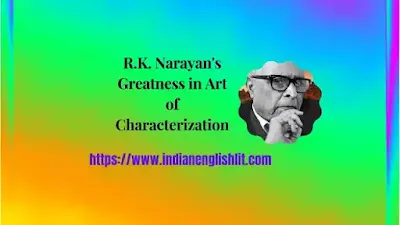Introduction:
A writer's greatness is measured by the characters he creates in his works. If a novelist's characters are like real human beings whom readers consider that they are like them, they make their creator great. In this respect R. K. Narayan is renowned for his presentation of characters. Actually a novel is a story about human beings and if the reader is not made to feel that they are convincing human beings the story cannot move the reader. In this regard Narayan succeeds a lot. His stories are really moving stories; they impress us by their characters.
 |
| R.K. Narayan's Greatness in Art of Characterization |
Middle Class Characters:
Narayan has achieved greatness in the field of characterization because he is fully aware of his range of works within it. Narayan belongs to a middle class family of South India. He is intimately familiar with their life and manner. He knows what type of life they live. He knows their weakness and shortcomings. He has good knowledge of their aspirations. Narayan does not go beyond his range. His canvas is limited and he does not present too many characters in his novels. His preoccupation is with the middle class, a relatively small part of an agricultural civilization and the most conscious and anxious part of the population. Its members are neither very rich nor too poor to be degraded by want and hunger. Some of his characters have a lust for money but they don't get corrupt. They are not involved in illegal activities, they have their virtues but they are not innocent like angels. They all have ambition to rise above the masses.
The Hero— His Struggles and Aspirations:
Narayan's hero comes from middle class of society but they are engaged in different occupation. They all struggle hard to improve their condition or achieve eminence in the society in which they live. But they are neither of the same type nor is their struggle of similar nature. The struggle to attain the aim of their life varies from novel to novel. The chief protagonists in Narayan's novels are student, teacher, financial expert, film actor, a fighter for emancipation, guide and sweet vendor. But the most outstanding quality of these characters is that they are presented in Indian colour and they seem to belong to a substantial human nature. The primary aim of all these characters is to attain, in the words of Chandran in The Bachelor of Arts, a life freed from distracting illusions and hysterias. At first their intention is not explicit. It remains buried under the habits of ordinary life, personal responsibilities and the heavy burden which they in from their families. As the plot of the novels develops their intentions become clear there appears a crisis in their lives to achieve their novels. They don't give up their struggle because of the difficulties and hardships that come in their way of attaining their aim. They are resolved to get success in their mission.
His Education and Maturity:
The hero of Narayan's novel is not at all heroic. He is an ordinary human being like most of us. He has his virtues and weaknesses. Each novel depicts the hero's struggle towards maturity and education of the main protagonist. As the action proceeds, he struggles to attain maturity and each stage in this struggle is defined carefully, minutely and precisely. The story of the novel describes hero an ordinary individual who is living a day to day life fights heroships, grows wiser and attain maturity through his struggle. In this way, he undergoes various changes mental and psychological and it cannot be said as has been pointed out by some critics that Narayan's characters are flat characters, that they are not rounded, three dimensional figures.
Minor Characters:
Narayan has introduced many minor characters in his novels. But Narayan fails in presenting a variety of minor characters. He concerns himself with man rather than men. Hence, his minor characters are flat. They do not change and grow but even then they are interesting and please the reader. For example, the adjournments lawyer, a character who repeatedly appears in Mr. Sampath, the main actor of Malgudi and the guide, and the cousin and the sweet vendor. Their actions can be predicted, but one does not feel bore of them because they assume new shape in each novel.
No Unredeemed Villain:
Narayan is very realistic in the portrayal of his characters. His heroes are unheroic and his villains are not devoid of virtues. They are not monstrous. In the true sense of the word they can't be called villain for they do not commit any such crime as the villains in Shakespeare's or Webster's tragedies commit. Nor are they like the Fagin of Oliver Twist. They commit sin which most of people are forced to commit in adverse circumstances. No doubt Mr. Sampath, Margayya and even Raju are not quite honest. True also that Rosie is not an ideal wife. But a close study of the ups and downs of life exhibits that there is a lot of good in these characters, that they are more sinned against than sinning and that they deserve our sympathy and pity. He suggests that everyone has his own virtues and vices and it would be unfair to pass unfair remarks on their mistakes which they commit under the pressure of circumstances. They too possess inherent goodness but under adverse circumstances, they become like a twig that is tossed here and there by every Zephyre that blows. Hence, they are more to be pitied than despised. Often they go down and commit sins despite their best efforts to the contrary as if they are being controlled by some superior power that is destined to put them down. In this sense destiny seems to determine character in Narayan's novels. But even the villains in Narayan's novels are not unredeemable.
The Three Categories:
Narayan's characters may well be grouped in three categories. First, there are characters who are easy to be understood. Narayan's heroes like Swami. Chandran, Krishna, Srinivas and Natraj belong to this group. They are kind and considerate but they have their weakness and hesitations. They lack self - confidence and determination and fail to assert themselves. They are on the whole passive characters unheroic who do not act but are acted upon.
In the second group, fall such intricate or complex characters, as Raju, Ramani, Mr. Sampath, Margayya and H. Vasu the man eater of Malgudi. They are inconsiderate and unpredictable in their ways and so it is difficult to understand them. They are inconsiderate and selfish in their plans of actions. They either want to acquire money or gratify the sexual lust and in order to achieve these aim they are ready to sacrifice every other thing and every other person because of their over involvement with sex and money. They affect the lives of others. But they are not so wicked as cannot be redeemed. for they do not cause any harm to others intentionally . They know their mistakes and are repentant for their misdeeds. They are fascinating much more fascinating than colourless. They are tempted by evil about them. They have the virtues of dynamism, intelligence and shrewdness and they make determined efforts to achieve their objectives. It is also to be noted that Narayan has the ability of distinguishing between different varieties of the same characteristic, the unfaithfulness of Romani is quite different from Mr. Sampath's neglect of his wife and children. Similarly Mr. Sampath and Raju are all after obtaining money by fair or foul means but their ways are quite different. Margayya is shrewd and cunning but Mr. Sampath and Raju are unscrupulous.
Thirdly, there are the odd and grotesque characters usually given insignificant roles, but they provide great amusement and entertain us in their different ways. Like Dickens, Narayan is fascinated by the odd and the eccentric inhuman character and action and does not fail to communicate his own amusement to his readers. Such oddities and eccentricities are exaggerated to make the characters delightful and curious. Marco in The Guide, Verraswami, the grumbler, Kailash the drunker debauch, the adjournment lawyer, etc. are all fascinating eccentrics. Their depiction may not be realistic but even then none would wish them away for that reason.
Women Characters:
Narayan has delineated two types of women characters. First there are women who are true to Indian traditions. They are simple, modest, gentle, faithful, loving and obedient. They are religious minded and upholders of the ancient way of life. Their only concern is to keep their husbands and children happy. They are expert in maintaining their household affairs efficiently and economically, Krishna's wife Savitri is such an idle woman. Such woman when grow old, more mature and experienced become more independent and assertive. Raju's mother in Guide and Krishna's mother and the mother of Chandran are such type of women.
The second class of women characters is generally opposite to the first class. They are more modernised, more unconventional, in their views of life they are flirt or butterfly type women who make man prey of their charm and attraction. They do not care for traditional norms or virtue and chastity. Rosie in the Guide and Shanti and Shanta Bai are such type of women. Rangi in The Man - Eater of Malgudi represents a cruder type for she is a professional prostitute. She is not ashamed of her profession nor does she try to conceal it. In this way, Narayan has sketched the characters of almost all types of women.
Children and Child Psychology:
Narayan displays great skill and deep knowledge of child psychology in depicting the character of children. This is best seen in his early novels: Swami and Friends and The Bachelor of Arts. In these two novels, Narayan has dexterously portrayed different aspects of children's life. There is hardly anything that has not been described in this novel. The novelist tells children's horror of Monday's, their joys and sorrows, their boyish Enjoyments, they petty quarrels which are soon forgotten and friendships restored. Besides giving a vivid description of children's world, Narayan also tells us how grown up people appear to children. Children have a tendency to exaggerate and it requires great psychological insight and understanding to portray the world from a child's point of view. The characters of Swami, Mani Shankar, Somu and Rajam are painted superbly and remind us of the children's world created by the famous English novelist Dickens.
Both Types and Individuals:
Narayan's characters are both types and individuals. They belong to some particular type or class but they retain their individuality. They have their own peculiar qualities. For example, Rosie is a typical flirt lets Raju seduce her but she is individualised in as much as she has great concern for her husband, appreciates his generosity and wishes to go back to her. Natraj and Margayya are typical of their class, but they, too have their own individual quality. In the same way Shanta Bai in spite being adventurers is deftly discriminated from other women of her type or class.






